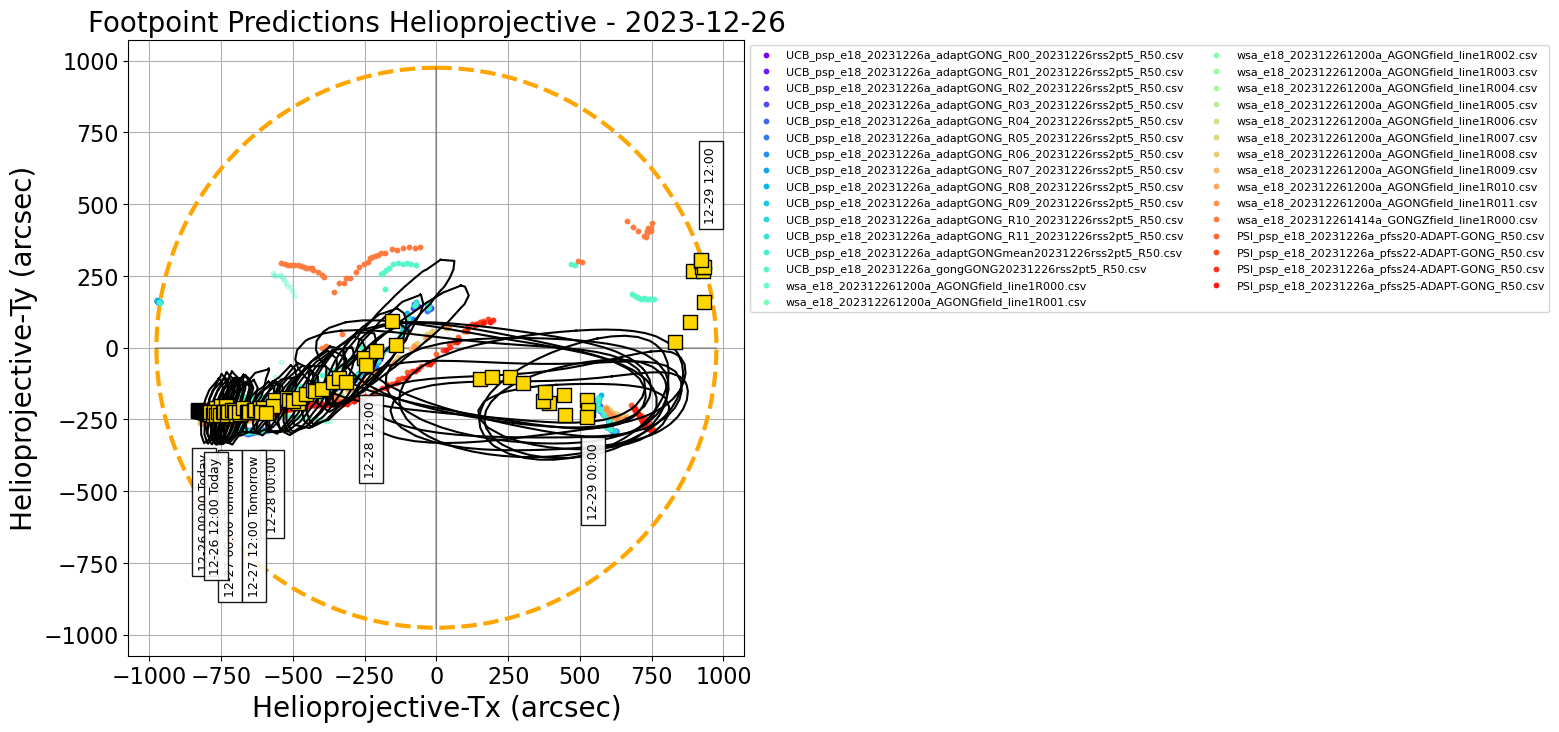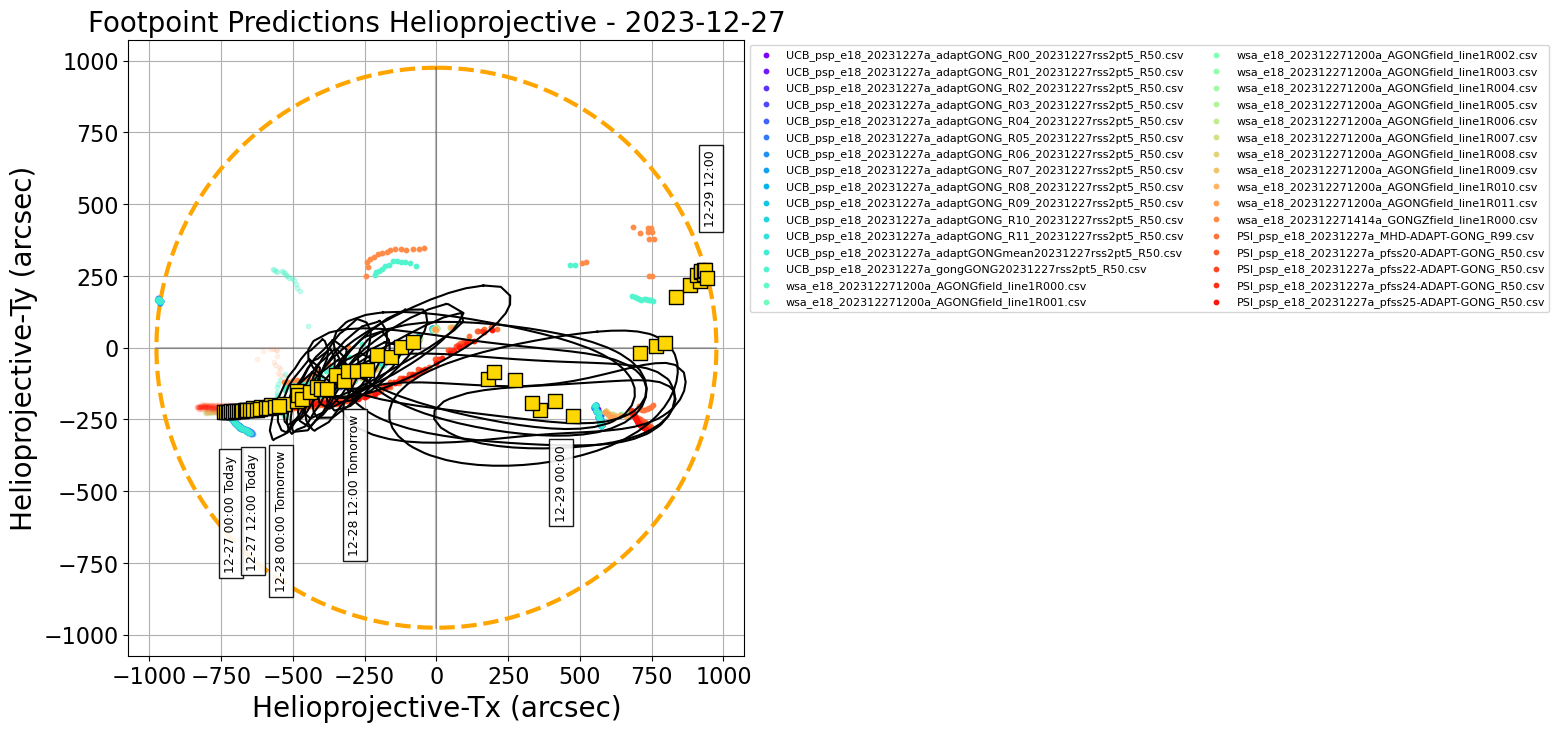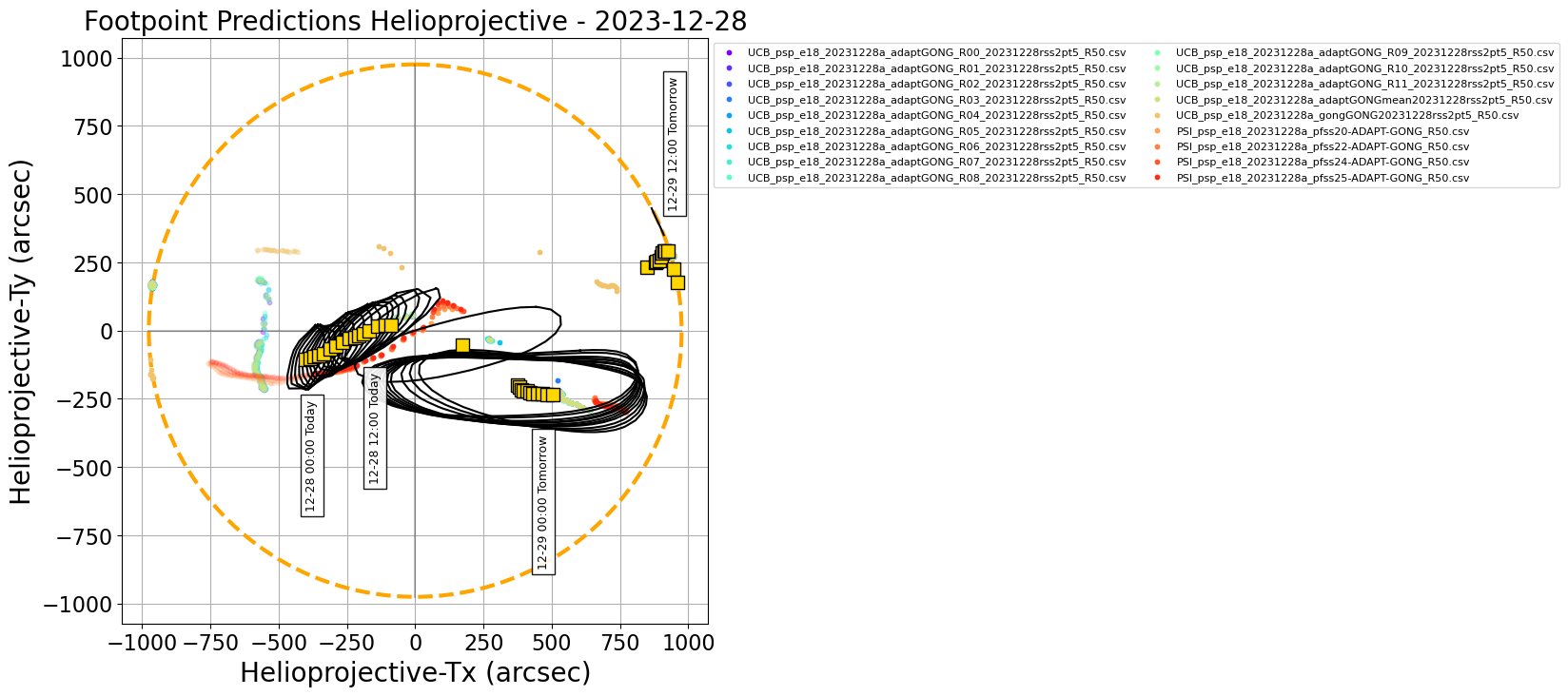
Refer to PSP 18th Perihelion Campaign page.
2023-12-26 (CSV, PDF table of coordinates)

Figure 1.

Figure 2.
Figures above show one footpoint per day plotted on the solar disk and in Carrington coordinates (click on figure to zoom and see caption).
The predicted footpoints were kindly provided by the PSP 18th Perihelion modeling team.
Encounter 18 Prediction update (1/3): 2023/12/26
This is the first footpoint prediction issued for Parker Solar Probe Encounter 18, reaching 11.4Rs at perihelion on 12/29. The spacecraft magnetic footpoints are currently situated on a coronal hole near the east limb but will rapidly sweep across almost the disk connecting to the active region bands before going over West limb just after perihelion on 12/29.
Connectivity starting today and lasting until the end of the day UT 12/27 is to a prominent equatorial coronal hole that can be seen here: https://sdo.gsfc.nasa.gov/assets/img/browse/2023/12/26/20231226_162859_1024_0211.jpg and has persisted from the last corotation. The footpoints will initially corotate with this source before starting to move quickly prograde as 12/28 begins. From 12/28 onwards, the footpoints advance rapidly across disk, without clear coronal hole sources but instead mapping to first the southern then the northern active region band with the transition occuring around 12/29 0500 UT. Footpoints are predicted to rotate off the west limb around 1400UT on 12/29.
*** Please note that the "arrival time" and "emission time" and associated Tx/Ty coordinates for both are reported in the consensus CSV file. The attached plots show the "arrival time" (location of source at time that plasma will arrive at PSP). See https://docs.google.com/presentation/d/1mz02FU24vqKxxLRaJlyScfAh8gB07iOlBsTHApvhls8 for some discussion on these***.
2023-12-27 (CSV, PDF table of coordinates)

Figure 1.

Figure 2.
Figures above show one footpoint per day plotted on the solar disk and in Carrington coordinates (click on figure to zoom and see caption).
The predicted footpoints were kindly provided by the PSP 18th Perihelion modeling team.
Encounter 18 Prediction update (2/3): 2023/12/27
This is the second of three footpoint predictions issued for Parker Solar Probe Encounter 18, reaching 11.4Rs at perihelion on 12/29. The spacecraft magnetic footpoints remain situated on a coronal hole which is now moving towards disk center, but starting tomorrow will rapidly sweep across almost the remainder of disk connecting to the active region bands before going over West limb just after perihelion on 12/29.
Connectivity today until the end of today UT (12/27) remains on a prominent equatorial coronal hole that can be seen here : https://sdo.gsfc.nasa.gov/assets/img/browse/2023/12/27/20231227_160923_1024_0211.jpg and has persisted from the last corotation. The footpoints will start to move quickly prograde starting early UT on 12/28. First, they will track along the western edge of the same coronal hole until around 1900UT on 12/28, before jumping to first the southern then the northern active region band with the latter transition occurring around 12/29 0200-0500 UT. Footpoints are predicted to rotate off the west limb around 1400UT on 12/29 with AR band connectivity just north of the equator.
*** Please note that the "arrival time" and "emission time" and associated Tx/Ty coordinates for both are reported in the consensus CSV file. The attached plots show the "arrival time" (location of source at time that plasma will arrive at PSP). See https://docs.google.com/presentation/d/1mz02FU24vqKxxLRaJlyScfAh8gB07iOlBsTHApvhls8 for some discussion on these***.
2023-12-28 (CSV, PDF table of coordinates)

Figure 1.

Figure 2.
Figures above show one footpoint per day plotted on the solar disk and in Carrington coordinates (click on figure to zoom and see caption).
The predicted footpoints were kindly provided by the PSP 18th Perihelion modeling team.
Encounter 18 Prediction update (3/3): 2023/12/28
This is the final footpoint prediction issued for Parker Solar Probe Encounter 18 before its perihelion at 11.4Rs tomorrow (12/29). The spacecraft magnetic footpoints are today in motion along an equatorial coronal hole on disk center before sweeping across almost the remainder of disk connecting to the active region bands before going over West limb just after perihelion.
Connectivity today moves prograde and northward on the same prominent equatorial coronal hole on disk (https://sdo.gsfc.nasa.gov/assets/img/browse/2023/12/28/20231228_162959_1024_0211.jpg) through 1500 UT today. For the rest of today and tomorrow, we continue to predict footpoints advancing rapidly across the active region bands but instead mapping to first the southern then the northern active region band with the transition occurring around 12/29 0300. Footpoints remain predicted to rotate off the west limb around 1400UT on 12/29.
*** Please note that the "arrival time" and "emission time" and associated Tx/Ty coordinates for both are reported in the consensus CSV file. The attached plots show the "arrival time" (location of source at time that plasma will arrive at PSP). See https://docs.google.com/presentation/d/1mz02FU24vqKxxLRaJlyScfAh8gB07iOlBsTHApvhls8 for some discussion on these***.
Date and arrival time of plasma parcel at PSP, consensus carrington longitude (deg), latitude (deg), error in longitude, error in latitude, on-disk position of predicted source in X and Y (arcseconds) at arrival time, date and emission time of plasma parcel at the source, on-disk position of predicted source at time parcel is emitted. Each row is the updated source location each hour.
The consensus is generated by forming a distribution of footpoint predictions from all modelers for each hour period, and attempting to fit a Kent distribution. If the fitting fails, the median in longitude and latitude are quoted. If the fitting is successful, the quoted errors are formed by drawing random samples from the fitted distribution and computing the standard deviation in longitude and latitude of those samples. If the fitting fails, the quoted errors are the standard deviation in the longitude and latitude from the raw distribution of predictions. The full shape of the distribution is described by black contours in the associated plots on this website. More details about the procedure can be found at the following preprint of Badman et al. (2023) "Prediction and Verification of Parker Solar Probe Solar Wind Sources at 13.3Rs"
Please note the carrington coordinates (lon,lat) are valid from the quoted timestamp (in UTC) until the next timestamp. The helioprojective coordinates quoted (HP-Tx, HP-Ty) are computed from the carrington coordinate at the quoted timestamp (e.g. midnight UTC each day) and so are valid instantaneously at this time but will corotate with the Sun until the next quoted timestamp. For a discussion of the subtle difference in emission and arrival time and why both are included please see the slide deck.
Individual model prediction tables of coordinates may be found in a Public DropBox. Files in the Public DropBox have three-letter identifiers indicating the associated model (see below).
Three-letter designation for Public DropBox: UCB. Kindly provided by Sam Badman. The model is a simple ballistic propagation from PSP down to the source surface assuming slow wind 360km/s, and then tracing this sub-PSP trajectory through a PFSS model to get footpoints at the photosphere. The source surface height here is 2.5Rs. The PFSS model is generated using various ADAPT maps with GONG and HMI as input, and the model is run using the open source pfsspy package. A more detailed explanation of the model and comparison to PSP E1 results are given here.
Three-letter designation for Public DropBox: PSI. Kindly provided by Pete Riley. For these predictions, PSI is using a combination of modeling approaches, including PFSS solutions, empirically-based polytropic MHD solutions, and a more sophisticated approach that includes the effects of waves and turbulence to heat the corona and the WKB approximation for wave pressures to accelerate the solar wind. Additionally, boundary conditions are derived from both HMI and ADAPT synoptic magnetograms. Together, these allow us to generate a rich set of ensemble realizations from which to make our optimal prediction, as well as pool them with other teams’ forecasts to derive a hyper-ensemble prediction.
Three-letter designation for Public DropBox: wsa. Kindly provided by Shaela Jones. The Wang-Sheeley-Arge (WSA) model is a combined empirical and physics-based model of the corona and solar wind. The coronal portion of the Wang-Sheeley-Arge (WSA) model is comprised of the Potential Field Source Surface (PFSS) and Schatten Current Sheet (SCS) models, where the output of the PFSS model serves as input to the SCS model. The solar wind portion of WSA consists of a simple 1-D kinematic propagation code that takes stream interactions into account in an ad-hoc fashion. It provides predictions of the solar wind speed and interplanetary magnetic field IMF polarity at any specified point in the inner heliosphere. The WSA model can use global maps of the photospheric magnetic flux measurements from a number of sources as its inner boundary condition; here we are using an ensemble of maps from the Air Force Data Assimilative Photospheric Flux Transport (ADAPT) model, based on input GONG magnetograms.
UAH predictions come from the University of Alabama, Huntsville Multiscale Fluid-Kinetic Simulation Suite (MS-FLUKSS, Pogorelov et al. (2014); Pogorelov (2023); Singh et al. (2022)), which can solve the Reynolds-averaged ideal MHD equations for the mixture of thermal and nonthermal solar wind ions coupled with the kinetic Boltzmann equation describing the transport of neutral atoms. An adaptive mesh refinement technique can be employed for efficient high-resolution calculations. The MS-FLUKSS heliospheric MHD model is coupled with the WSA model (Kim et al., 2020), which uses both ADAPT-GONG and ADAPT-HMI input magnetograms, with the PFSS source surface height and the WSA outer boundary at 2.5 and 10 solar radii, respectively. Hence, field line tracing is performed through the MHD domain down to 10 solar radii instantaneously at approximately 1 hour cadence, where the origin of the field line on the photosphere is already known, as described for WSA.
see Prediction and Verification of Parker Solar Probe Solar Wind Sources at 13.3Rs, Badman et al. (2023)